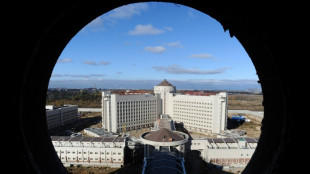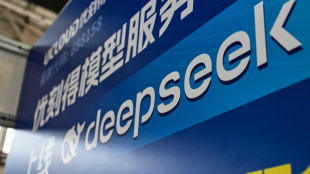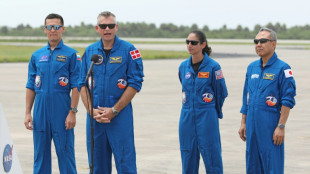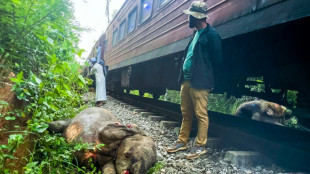-
 France's agriculture show, an outlet for angry farmers
France's agriculture show, an outlet for angry farmers
-
China's EV maker XPeng eyes doubling global presence by year's end

-
 Germany on eve of elections under shadow of US-European rift
Germany on eve of elections under shadow of US-European rift
-
France still seeking to block EU-Mercosur trade deal: Macron

-
 Ukraine's earth riches are rare and difficult to reach
Ukraine's earth riches are rare and difficult to reach
-
On $15 a month, Venezuela's teachers live hand to mouth

-
 'See you in court': Trump, governor spar over trans rights
'See you in court': Trump, governor spar over trans rights
-
US stocks tumble on fears of slowdown

-
 Cuba opens solar park hoping to stave off blackouts
Cuba opens solar park hoping to stave off blackouts
-
German flying taxi start-up's rescue deal collapses

-
 Stock markets diverge, oil prices slide
Stock markets diverge, oil prices slide
-
'Queen of Pop' Madonna lambasts 'King' Trump

-
 Apple says halting data protection tool for UK users
Apple says halting data protection tool for UK users
-
Female chefs condemn sexism in British kitchens

-
 US, China economic leaders raise 'serious concerns' in first call
US, China economic leaders raise 'serious concerns' in first call
-
Russia sells famed imperial prison at auction

-
 Stock markets rise as Alibaba fuels Hong Kong tech rally
Stock markets rise as Alibaba fuels Hong Kong tech rally
-
France full-back Jaminet returns to rugby after racist video ban

-
 Chinese AI companies celebrate DeepSeek, shrug off global curbs
Chinese AI companies celebrate DeepSeek, shrug off global curbs
-
Asian markets advance as Alibaba fuels Hong Kong tech rally

-
 Nissan shares jump 11% on reported plan to seek Tesla investment
Nissan shares jump 11% on reported plan to seek Tesla investment
-
Trump aid cut imperils water scheme in scorching Pakistan city

-
 Just 17% of Japan citizens hold passport, data shows
Just 17% of Japan citizens hold passport, data shows
-
Most Asian markets rise as traders pick over week of headlines

-
 Japan's core inflation rate hits 19-month high
Japan's core inflation rate hits 19-month high
-
How a 'forgotten' Minnesota monastery inspired 'The Brutalist'

-
 Japan's core inflation rate hits 3.2% in January
Japan's core inflation rate hits 3.2% in January
-
Stocks mostly fall on tepid Walmart outlook, geopolitical worries

-
 Musk in X spat with Danish astronaut over 'abandoned' ISS crew
Musk in X spat with Danish astronaut over 'abandoned' ISS crew
-
Bond franchise shake-up moves spy into Amazon stable

-
 New York seeks hundreds of millions of dollars in 'vaping epidemic' case
New York seeks hundreds of millions of dollars in 'vaping epidemic' case
-
Moon or Mars? NASA's future at a crossroads under Trump

-
 Spotify adds more AI-generated audiobooks
Spotify adds more AI-generated audiobooks
-
Stocks in the red as investors worry about growth and inflation

-
 Bond franchise shifts to Amazon as Broccoli family steps back
Bond franchise shifts to Amazon as Broccoli family steps back
-
Unfair? Figures belie Trump's claims on EU trade balance

-
 Stock markets mostly lower on Fed concerns over Trump policies
Stock markets mostly lower on Fed concerns over Trump policies
-
France moves to ban marriage for undocumented migrants

-
 Walmart sales rise but shares tumble on forecast
Walmart sales rise but shares tumble on forecast
-
Spain court convicts ex-football chief for sexual assualt over forced kiss

-
 Mercedes-Benz flags cost cuts, tough year ahead after torrid 2024
Mercedes-Benz flags cost cuts, tough year ahead after torrid 2024
-
ECB rate hikes result in record loss in 2024

-
 Romanian director Jude shoots latest film in 10 days on an iPhone
Romanian director Jude shoots latest film in 10 days on an iPhone
-
Sri Lanka passenger train kills six elephants

-
 Stock markets mixed on Fed concern over Trump policies
Stock markets mixed on Fed concern over Trump policies
-
Birkenstock sandals are not art, German court rules

-
 Markets drop, gold hits record on Fed concern over Trump policies
Markets drop, gold hits record on Fed concern over Trump policies
-
Airbus profit climbs in 2024, aims to accelerate output

-
 Airbus proft climbs in 2024, aims to accelerate output
Airbus proft climbs in 2024, aims to accelerate output
-
Trump says trade deal with China 'possible'

Hungary: China's CATL battery factory
China’s Contemporary Amperex Technology Co. Limited (CATL), one of the world’s leading battery manufacturers, is making significant progress on its highly anticipated battery production facility in Hungary. With an investment of several billion euros, the new factory aims to meet the growing demand for electric vehicle (EV) batteries across Europe and further solidify the region’s push toward sustainable mobility.
A Strategic Location:
The factory is situated in Debrecen, eastern Hungary, a location carefully chosen for its advantageous infrastructure, skilled workforce, and proximity to major European automotive hubs such as Germany, Austria, and the Czech Republic. Debrecen’s well-developed logistics network enables CATL to efficiently supply batteries to some of the world’s top carmakers, many of which are currently expanding their EV lineups to comply with the EU’s stricter emissions targets.
Boosting Local Economy and Workforce:
Hungarian officials have enthusiastically welcomed CATL’s presence, citing economic growth and job creation as key benefits. Thousands of direct and indirect jobs are expected to arise from the factory’s construction and eventual full-scale operation. Local universities and technical schools have already initiated programs to train and upskill workers, fostering a long-term partnership between CATL and the Hungarian education sector.
Technological and Environmental Aspects:
CATL’s Hungarian plant is designed to showcase cutting-edge battery technology, featuring advanced research and development capabilities. The company has emphasized its commitment to high efficiency and environmental standards—an essential factor as Europe’s automotive industry strives for greener solutions. Nonetheless, environmental groups in Hungary and neighboring countries have expressed concerns about potential impacts on local ecosystems, water consumption, and waste management. CATL has responded by pledging transparent environmental practices and adherence to EU regulations.
A Key Piece in Europe’s EV Puzzle:
As European governments ramp up policies to combat climate change, automotive manufacturers rely heavily on stable battery supplies for their electrified models. CATL’s new factory in Hungary stands to become a linchpin in the region’s EV supply chain, reducing reliance on Asian imports and contributing to a more robust, localized production infrastructure. Industry analysts believe the plant will not only bolster Europe’s electric vehicle market but also stimulate competition, driving innovation and potentially lowering battery costs.
Whether viewed from the standpoint of industrial expansion, technological advancement, or environmental oversight, CATL’s battery factory in Hungary represents a monumental development in Europe’s journey toward a more sustainable transportation sector. The coming years will reveal just how transformative this Chinese-led investment will be for Hungary, the European automotive industry, and the broader global push for green mobility.

NATO is training to fight cyber attacks

Digital Ocean Twin: Protecting the Oceans

Digital Ocean Twin: Protecting the Oceans

What is the outlook for France’s economy?

How melting Alpine glaciers affect valleys

The EU Commission and its climate targets?

The EU Commission and its climate targets?

Irish government to subsidise school books

European democracy is weakening, report warns

Low demand: electric vehicles clog Belgian port




